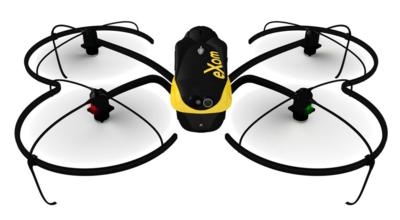Wed, May 06, 2015
eXom Says senseFly’s New Aircraft 'Ready For Take-Off'
Swiss professional UAV maker senseFly has launched the eXom, its highly-anticipated quadcopter UAS for mapping and inspection. The eXom is available to pre-order immediately and ships this summer.

The eXom is a uniquely sensor-rich system. Developed by experts working across numerous fields of robotics, this lightweight quadcopter offers professionals such as civil engineers and land surveyors the situational awareness, imaging flexibility and durability they need to complete challenging tasks safely, accurately and efficiently.
“We believe the eXom’s level of application-focused technology is unique in the civilian drone market,” said Antoine Beyeler, CTO and co-founder of senseFly. “This platform tightly integrates several one-of-a-kind features, such as TripleView imaging, advanced situational awareness and full flight mode flexibility—to provide inspection and mapping professionals with the functionality they desire from a rotary system.”
eXom is a future-ready platform with a quad-core computer onboard. Like senseFly’s fixed-wing drones, it offers users ever-evolving performance through regular software updates, adding the latest drone tech innovations to keep the eXom at the cutting edge for years to come.
The company says eXom’s low take-off weight of 3.7 pounds ensures its users will, in many countries, have less flight authorization paperwork to deal with than those who use heavier systems.
The eXom contains a rich array of advanced integrated sensors. These work together to provide the user with full situational awareness and support obstacle avoidance:
- Five ‘navcam’ vision sensors allow the operator to see in the direction the drone is moving, automatically via its flight control software, without needing to turn the system’s TripleView camera head. This technology is unique in such a lightweight UAS, similar to the visual parking sensors in modern cars, but brought into a 3D flight environment.
- Five ultrasonic proximity sensors work in harmony with eXom’s navcams to ensure the operator always knows the drone’s distance from nearby objects. (The drone’s shock-absorbent carbon fibre shrouding is also always on hand to protect its rotors in case of surface contact.)
- Numerous other sensors, including inertial measurement units, barometers, magnetometers, GPS and magnetic encoders, maximise the drone’s stability and safety.

Additionally, the company says eXom’s autopilot-controlled TripleView camera head enables the user to view and record three different types of imagery during a single flight without needing to land to change cameras.
Since the TripleView head faces forwards, eXom can fly up close to target structures such as building walls and dams to achieve sub-millimetre data resolutions. Plus, because of the head’s 270° vertical field of view, users can document objects positioned directly above and below the drone; crucial for tasks such as bridge and roof inspections.
eXom offers several flight plan modes, including:
- Autonomous mode, which allows operators to create a flight plan using eMotion X’s mission blocks. The aircraft then launches, flies, acquires geo-referenced imagery and lands itself.
- Interactive ScreenFly mode, a streaming video mode for live inspection tasks. The supplied joypad allows the operator to navigate and orientate the drone via computer screen. This mode includes flight assistance features such as cruise control and distance lock. Operators can switch back and forth between the two modes during flight.
- RC-based manual control always remains available as a backup function and for experienced pilots.
(Images provided by senseFly)

More News
Runway Centerline Lighting Flush centerline lights spaced at 50-foot intervals beginning 75 feet from the landing threshold and extending to within 75 feet of the opposite end of t>[...]
Aero Linx: Air Force Global Strike Command Air Force Global Strike Command, activated August 7, 2009, is a major command with headquarters at Barksdale Air Force Base, Louisiana, i>[...]
Also: Viasat-uAvionix, UL94 Fuel Investigation, AF Materiel Command, NTSB Safety Alert Norges Luftsportforbund chose Aura Aero's little 2-seater in electric trim for their next gli>[...]
Also: USCG Retires MH-65 Dolphins, Irish Aviation Authority, NATCA Warns FAA, Diamond DA42 AD This summer, history enthusiasts will have a unique opportunity to experience World Wa>[...]
Also: Moya Delivery Drone, USMC Drone Pilot, Inversion RAY Reentry Vehicle, RapidFlight UAVOS has recently achieved a significant milestone in public safety and emergency services >[...]
 ANN's Daily Aero-Term (04.30.24): Runway Centerline Lighting
ANN's Daily Aero-Term (04.30.24): Runway Centerline Lighting ANN's Daily Aero-Linx (04.30.24)
ANN's Daily Aero-Linx (04.30.24) Airborne 04.24.24: INTEGRAL E, Elixir USA, M700 RVSM
Airborne 04.24.24: INTEGRAL E, Elixir USA, M700 RVSM Airborne 04.29.24: EAA B-25 Rides, Textron 2024, G700 Deliveries
Airborne 04.29.24: EAA B-25 Rides, Textron 2024, G700 Deliveries Airborne-NextGen 04.23.24: UAVOS UVH 170, magni650 Engine, World eVTOL Directory
Airborne-NextGen 04.23.24: UAVOS UVH 170, magni650 Engine, World eVTOL Directory





